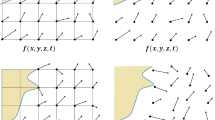Abstract
Recent advances in turbulence modeling brought more and more sophisticated turbulence closures (e.g. k-ɛ, k-ɛ -v 2-f, Second Moment Closures), where the governing equations for the model parameters involve advection, diffusion and reaction terms. Numerical instabilities can be generated by the dominant advection or reaction terms. Classical stabilized formulations such as the Streamline–Upwind/Petrov–Galerkin (SUPG) formulation (Brook and Hughes, comput methods Appl Mech Eng 32:199–255, 1982; Hughes and Tezduyar, comput methods Appl Mech Eng 45: 217–284, 1984) are very well suited for preventing the numerical instabilities generated by the dominant advection terms. A different stabilization however is needed for instabilities due to the dominant reaction terms. An additional stabilization term, called the diffusion for reaction-dominated (DRD) term, was introduced by Tezduyar and Park (comput methods Appl Mech Eng 59:307–325, 1986) for that purpose and improves the SUPG performance. In recent years a new class of variational multi-scale (VMS) stabilization (Hughes, comput methods Appl Mech Eng 127:387–401, 1995) has been introduced, and this approach, in principle, can deal with advection–diffusion–reaction equations. However, it was pointed out in Hanke (comput methods Appl Mech Eng 191:2925–2947) that this class of methods also need some improvement in the presence of high reaction rates. In this work we show the benefits of using the DRD operator to enhance the core stabilization techniques such as the SUPG and VMS formulations. We also propose a new operator called the DRDJ (DRD with the local variation jump) term, targeting the reduction of numerical oscillations in the presence of both high reaction rates and sharp solution gradients. The methods are evaluated in the context of two stabilized methods: the classical SUPG formulation and a recently-developed VMS formulation called the V-SGS (Corsini et al. comput methods Appl Mech Eng 194:4797–4823, 2005). Model problems and industrial test cases are computed to show the potential of the proposed methods in simulation of turbulent flows.
Similar content being viewed by others
References
Hauke G (2002) A simple subgrid scale stabilized method for the advection-diffusion-reaction equation. Comput Methods Appl Mech Eng 191:2925–2947
Tezduyar TE, Park YJ (1986) Discontinuity capturing finite element formulations for nonlinear convection-diffusion-reaction equations. Comput Methods Appl Mech Eng 59:307–325
Brooks AN, Hughes TJR (1982) Streamline upwind/Petrov–Galerkin formulations for convection dominated flows with particular emphasis on the incompressible Navier–Stokes equations. Comput Methods Appl Mech Eng 32:199–259
Corsini A, Rispoli F, Santoriello A (2005) A variational multiScale higher-order finite element formulation for turbomachinery flow computations. Comput Methods Appl Mech Eng 194:4797–4823
Lien FS, Kalitzin G, Durbin PA (1998) RANS modeling for compressible and transitional flows. Proceedings of the summer program 1998, Center for Turbulence Research, Stanford University, California pp 267–286
Corsini A, Rispoli F, Santoriello A (2004) A new stabilized finite element method for advection-diffusion-reaction equations using quadratic elements. MFF – modelling fluid flow – the state of the art. Springer, Berlin Heidelberg New York, pp 247–266
Tezduyar TE (2003) Computation of moving boundaries and interfaces and stabilization parameters. Int J Numer Methods Fluids 43:555–575
Hughes TJR (1995) Multiscale phenomena: Green’s functions, the Dirichlet-to-Neumann formulation, subgrid scale models, bubbles and the origin of stabilized methods. Comput Methods Appl Mech Eng 127:387–401
Hughes TJR, Feijòo GR, Mazzei L, Quincy J-B (1998) The variational multiscale method-a paradigm for computational mechanics. Comput Methods Appl Mech Eng 166:3–24
Durbin PA (1995) Separated flow computations with the k-ɛ -v 2 model. AIAA J 33:659–664
Elazar Y, Shreeve RP (1990) Viscous flow in a controlled diffusion compressor cascade with increasing incidence. ASME J Turbomach 112:256–266
Chen WL, Lien FS, Leschziner MA (1998) Computational prediction of flow around higly loaded compressor cascade blades with non-linear eddy-viscosity models. Int J Heat Fluid Flow 19:307–319
Tezduyar TE (1992) Stabilized finite element formulations for incompressible flow computations. Adv App Mech 28:1–44
Saad Y (1993) A flexible inner-outer preconditioned GMRES algorithm. SIAM J Sci Comput 14:461–469
Corsini A, Rispoli F, Santoriello A (2005) Quadratic Petrov-Galerkin finite elements for advective–reactive features in turbomachinery CFD. Int J Numer Methods Heat Fluid Flow 15(8):894–925
Hughes TJR, Tezduyar TE (1984) Finite element methods for first-order hyperbolic systems with particular emphasis on the compressible Euler equations. Comput Methods Appl Mech Eng 45:217–284
Author information
Authors and Affiliations
Corresponding author
Rights and permissions
About this article
Cite this article
Corsini, A., Rispoli, F., Santoriello, A. et al. Improved Discontinuity-capturing Finite Element Techniques for Reaction Effects in Turbulence Computation. Comput Mech 38, 356–364 (2006). https://doi.org/10.1007/s00466-006-0045-x
Received:
Accepted:
Published:
Issue Date:
DOI: https://doi.org/10.1007/s00466-006-0045-x




